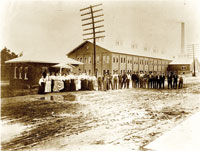Cover Story, by Julie Swidwinski
Location: Mt. Pleasant, Mid-Michigan
Population: 25,946
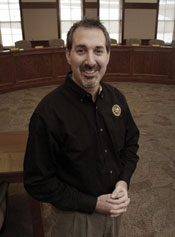 |
|
Mt. Pleasant Mayor Jim Holton |
After sitting vacant for the better part of 40 years, the Borden building was a fading vestige of Mt. Pleasant’s once flourishing agricultural industry. The structure—with its blighted exterior, frequent vandalism, and environmental contamination—was an eyesore to those entering the city’s Central Business District. It was even tagged as a “symbol for all that is not right with the downtown” in a 2003 Hyett Palma study. After fifteen failed attempts to restore the building, its future was bleak. However, the new millennium brought new ambitions for the building. Once its true potential was uncovered, the community quickly stepped up to save the historic Michigan treasure.
“Preserving our community’s past has always been a priority for our city,” said Mt. Pleasant Mayor Jim Holton. “This is never more evident than in our downtown, which is committed to maintaining historic architecture and finding modern reuses for prized structures.”
Constructed more than 100 years ago by the Borden Condensed Milk Company, the two-story commercial Italianate structure was built on the banks of the Chippewa River. The Michigan Condensed Milk Factory, also known as the Borden Creamery, was one of the few milk factories that produced both condensed milk and butter. In its glory days, the factory processed more than 200,000 pounds of milk per year from 500 local dairy farmers. After the factory was closed in the 1960s, however, the structure saw little use.
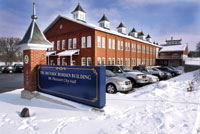 |
|
The finished building, photo by Tim Fitzgerald. |
Redevelopment of the factory proved difficult as the property was often overlooked as too small for developers with historic rehabilitation experience or too big for dreamers with minimal resources. Proposals to transform the Borden building into a community center, urban mall, university classrooms, post office, and more, came and went with little fruition.
“The stream of ideas to reuse the Borden building seemed endless,” said City Manager Kathie Grinzinger. “Over the decades, many proposals for adapting the landmark were examined, but nothing ever materialized. Finally, after 40 years had passed, it became evident that if the building was going to be saved, it needed to be done quickly.”
In early 2002, the city solicited proposals from developers willing to tackle the redevelopment of the aging industrial site. The J.E. Johnson Group of Midland presented a plan to purchase and rehabilitate the structure while maintaining its historic appeal. The assistance of numerous local and state organizations followed, with offers of various tax credits, environmental cleanup funds, and adaptations to historic regulations.
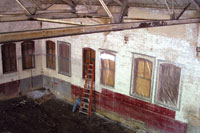 |
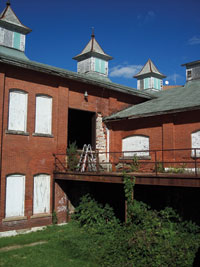 |
|
The Creamery restoration was a monumental undertaking of 40 years of trying and 17 attempts to pull it off. Using a photograph taken around 1910 as a guide, rehabilitation began brick-by-brick. The entire process was overseen by the Michigan State Historic Preservation Office and the local Historic District Commission. The project created a rallying point in the community and increased civic pride during tough times. |
The final piece of the funding puzzle lay in the hands of Mt. Pleasant residents. In 2005, residents approved the sale of the former city hall building, helping raise part of the $3.5 million needed to purchase a condominium in the Borden building. This 28,000-square-foot space would house the municipal offices. Residents knew the decision would ultimately raise their taxes .6 mills. In the end, the community enthusiastically supported the rehabilitation of the historic landmark by nearly a two-to-one margin.
“It was simply a momentous time for Mt. Pleasant,” Mayor Holton said. “The city was buzzing with pride because we knew that when all was said and done, the community was reinvesting in both our past and future.”
Since the Borden building is listed on the National Register of Historical Places, its rehabilitation had to be precise. The building’s exterior, along with key interior features, needed to match its original construction as closely as possible. The entire process was overseen by the Michigan State Historic Preservation Office and the local Historic District Commission.
Once cleanup and construction began in April 2007, crews faced a number of obstacles that could have halted the project. More than 20 artesian wells were discovered underground on the site that was to become a public parking lot. Tanks filled with contaminated molasses and unknown materials needed to be disposed. The brick smokestack and water tower, which served as historical landmarks to the residents, were too badly damaged for repair. Asbestos and lead paint removal delayed construction for weeks.
“At times it seemed like such a mess,” Grinzinger said. “But we knew that this cleanup was necessary to create a safer, more vibrant community for our residents.”
Using a photograph taken around 1910 as a guide, rehabilitation began brick-by-brick. Crews sifted through the building’s original 400,000 bricks, reusing those they could and incorporating matching replacements where needed. Old shingles and decking on the roof were removed. Specially milled, historically accurate tongue-and-groove decking was installed and covered with new green shingles that matched the original. Hundreds of windows were constructed to match the initial design, and eight magnificent cupolas, complete with handcrafted finials, were built on-site to sit atop the building.
 |
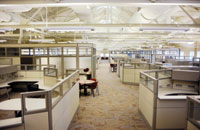 |
|
Rehabilitated interior as a state-of-the-art office space. City Hall was moved to the new building, with commission chambers located in the factory’s former boiler room. |
Although the exterior of the building is straight from a history book, the interior was rehabilitated into state-of-the-art office space. Mt. Pleasant’s municipal offices account for roughly 75 percent of the building. The city’s commission chambers are located in what was the factory’s boiler room that provided heat for the milk condensing process. The remainder of the structure is occupied by other tenants, resulting in an increased tax base for the city.
At the project’s completion stood a structure that enhanced the Mt. Pleasant community in more ways than one. In addition to developing the city’s first historic district, the project created a signature entrance to Mt. Pleasant’s west side and downtown community. The rehabilitation also spurred the expansion of the city’s Greg K. Baderschneider River Walk Trail; added public parking and completed the streetscape in the downtown area; and created a unique water feature that captures the flow from the discovered artesian wells. Mt. Pleasant’s overall investment in the project exceeded $7 million.
Since the building’s grand opening in December 2008, the efforts of the community have not gone unnoticed. Last year, the Borden building received the Governor’s Award for Historic Preservation. The project was also honored with a finalist nomination for the Michigan Municipal League’s Community Excellence Award and a presidential plaque from Keep Michigan Beautiful.
The Borden building continues to make the Mt. Pleasant community proud. Not only is it a reminder of the city’s rich history as the heart of central Michigan’s agricultural beginnings, but the forgotten factory turned state-of-the-art structure also serves as an example of how preservation can meet the needs of the 21st century.
“We can save our past and build our future, without sprawl, strengthening our city centers,” said an editorial written in the Morning Sun, a daily newspaper that serves central Michigan. “We can do it when the right dreams meet the right incentives—and in the Borden building project, they did.”
 A Timeline of the Historic Borden Building
A Timeline of the Historic Borden Building
- Construction of the condensed milk factory began in January 1907, and was completed in less than six months.
- Approximately 40,000 cubic feet of concrete was laid in the foundation and floors.
- The foundation of the 125-foot smokestack contained more than 4,500 cubic feet of concrete and extended down to the “hard pan” (bed rock).
- Roughly 75 tons of roofing steel was used, with roof shingles made of asbestos slate. The material, when first used, was heralded for its fire retardant properties.
- The building contains four layers of brick; more than 400,000 in all.
- A large whistle was used to notify factory workers of specific times during the day: 7 am, 7:15 am, noon, 1 pm and 6 pm.
- Monday, May 15, 1908 was the first day milk was processed. At the end of the first day, 10,000 pounds of milk were processed, just a third of the overall capacity of the factory.
- A grand opening was held with an eight-piece orchestra playing. Men were charged 25 cents each to help defray the costs of the party. More than 2,500 people attended the open house.
Julie Swidwinski is the community information coordinator for the city of Mt. Pleasant. You may reach her at 989-779-5322 or [email protected].
